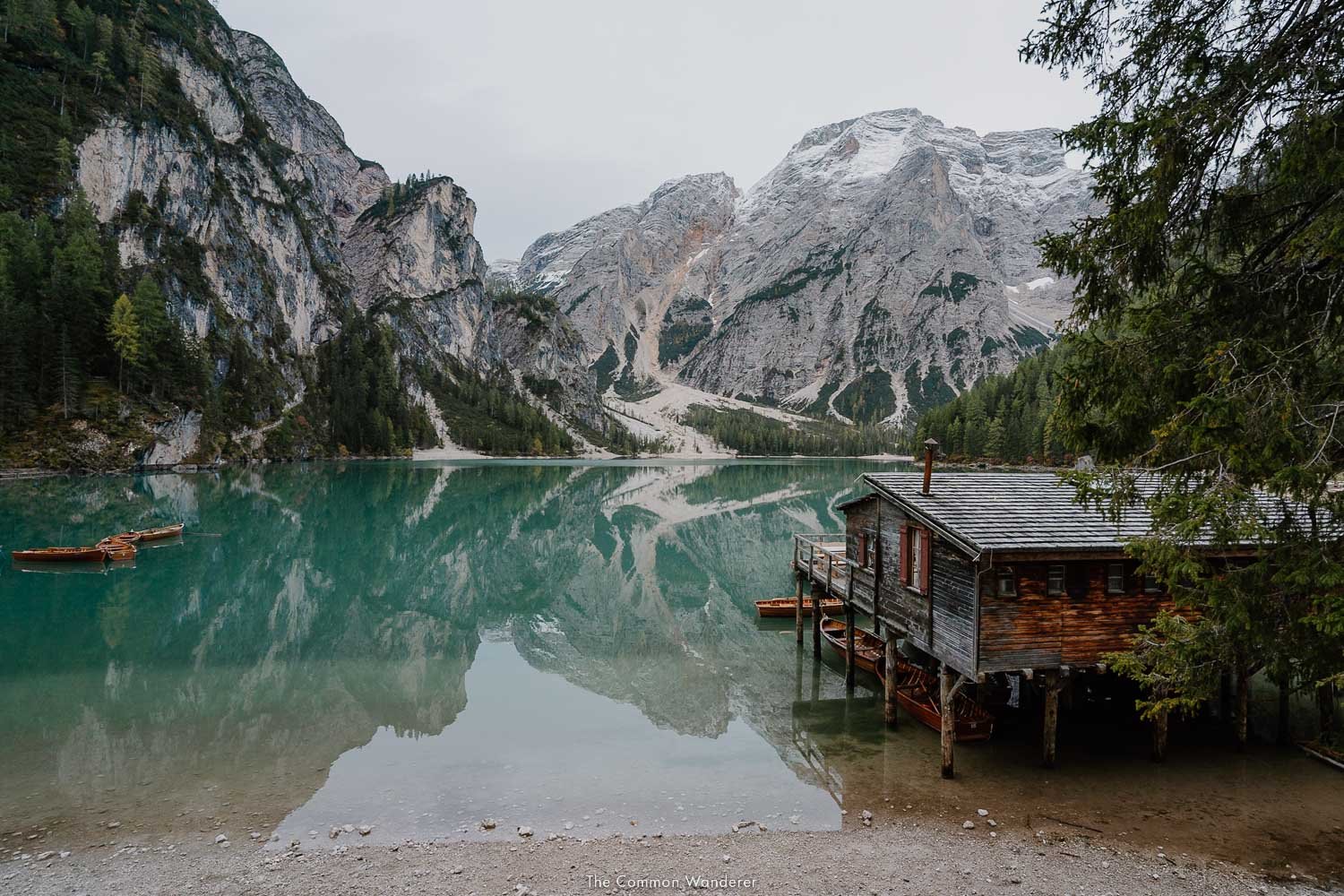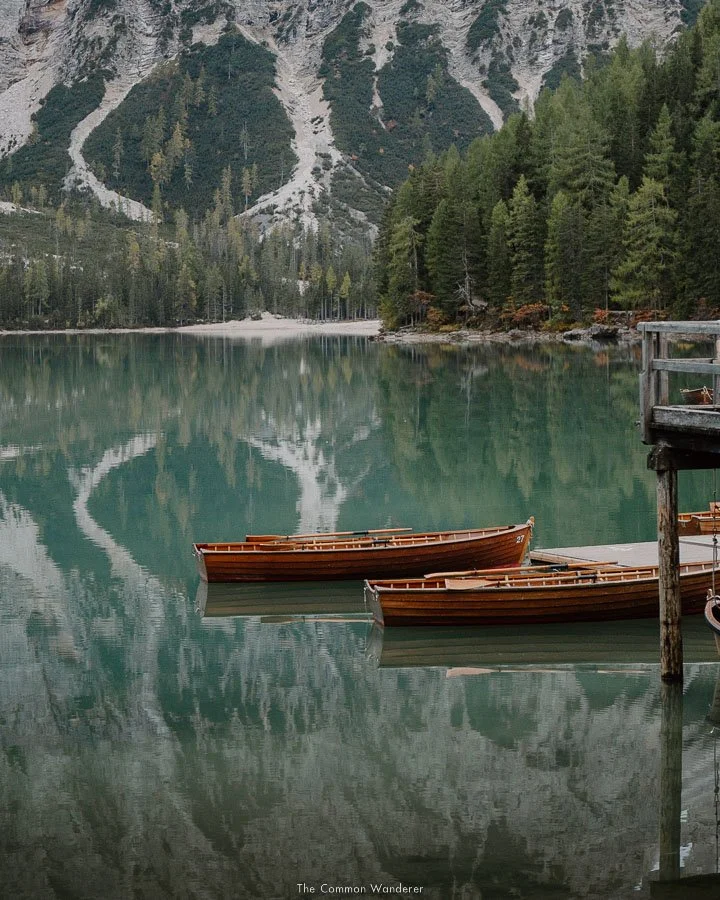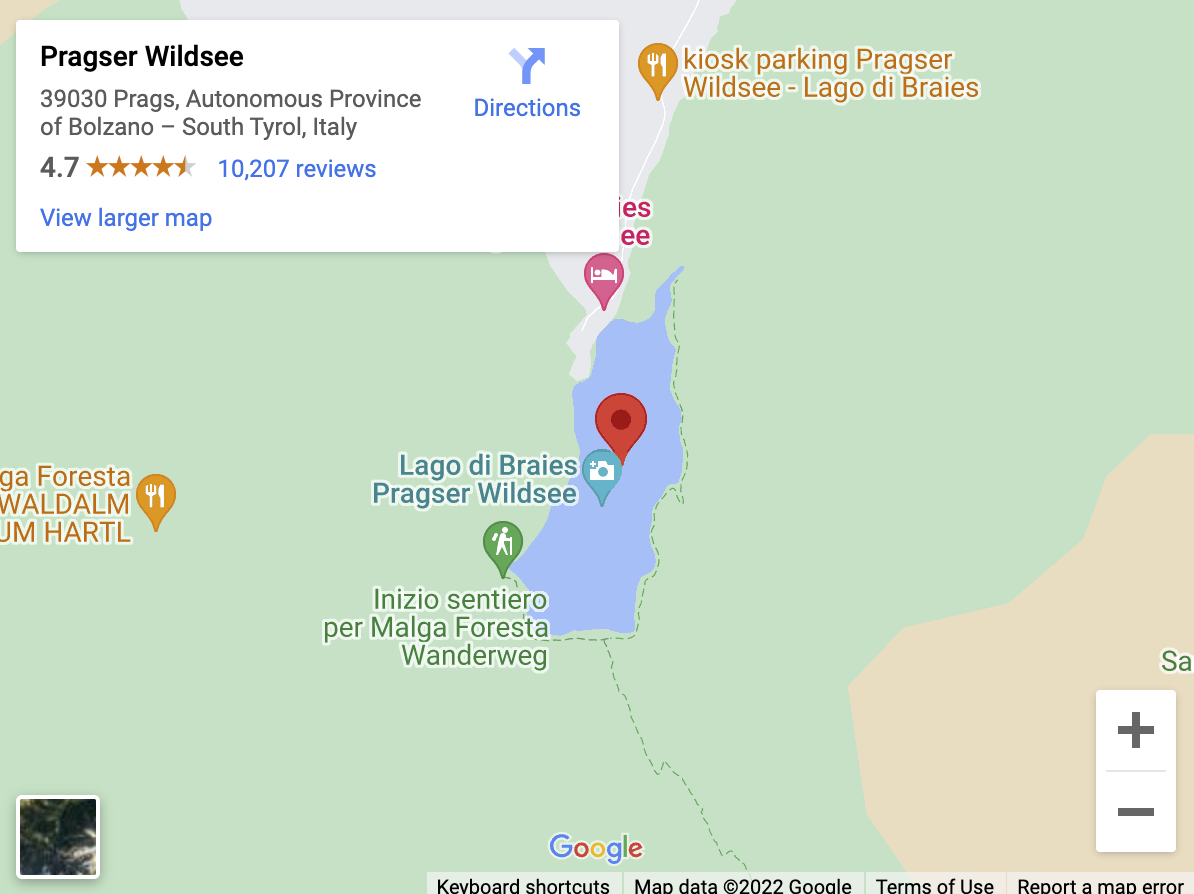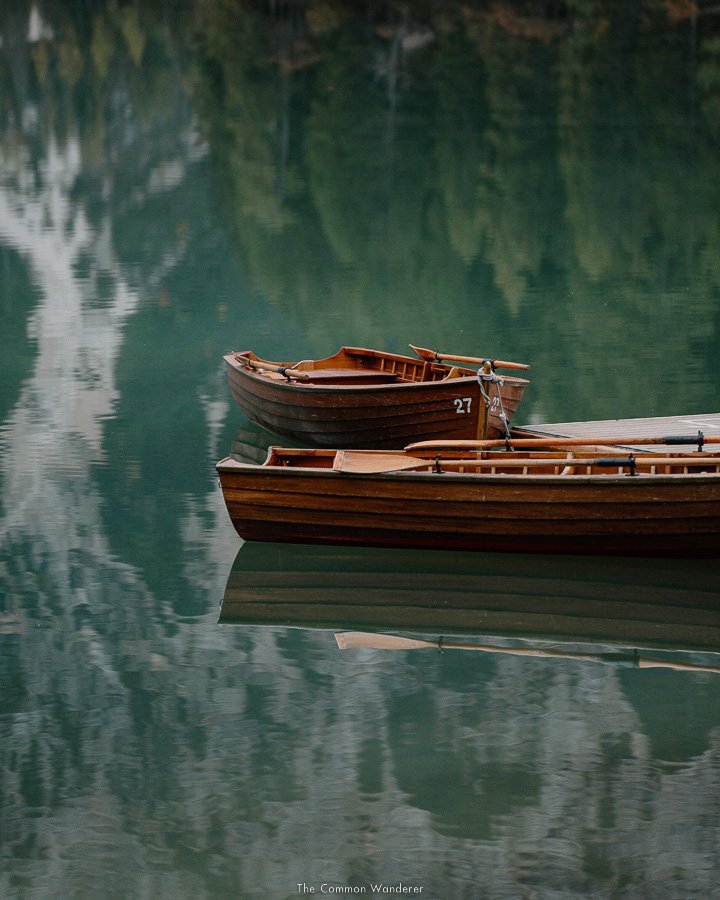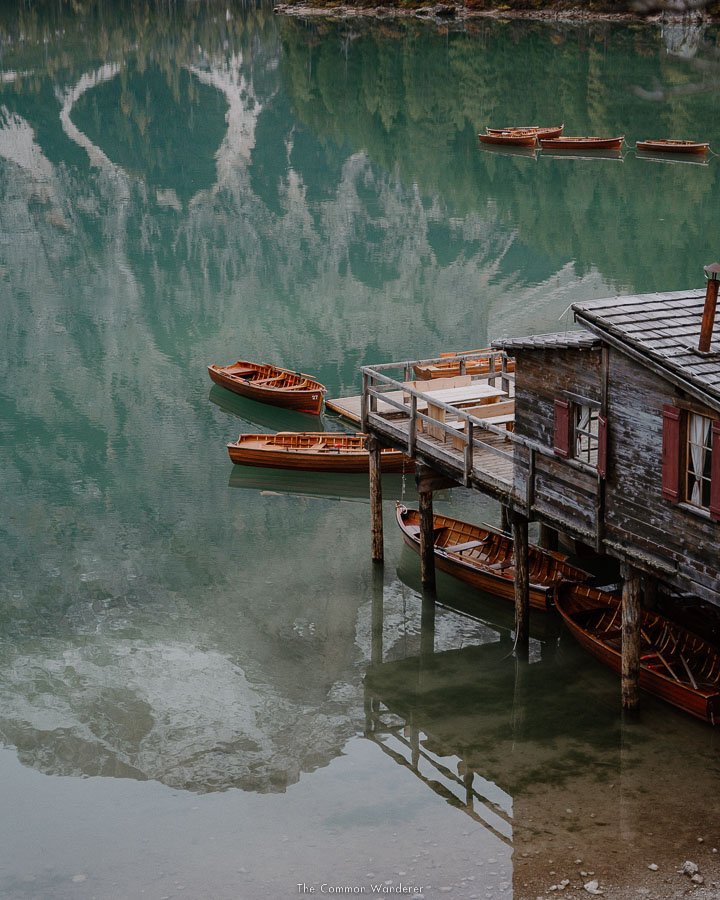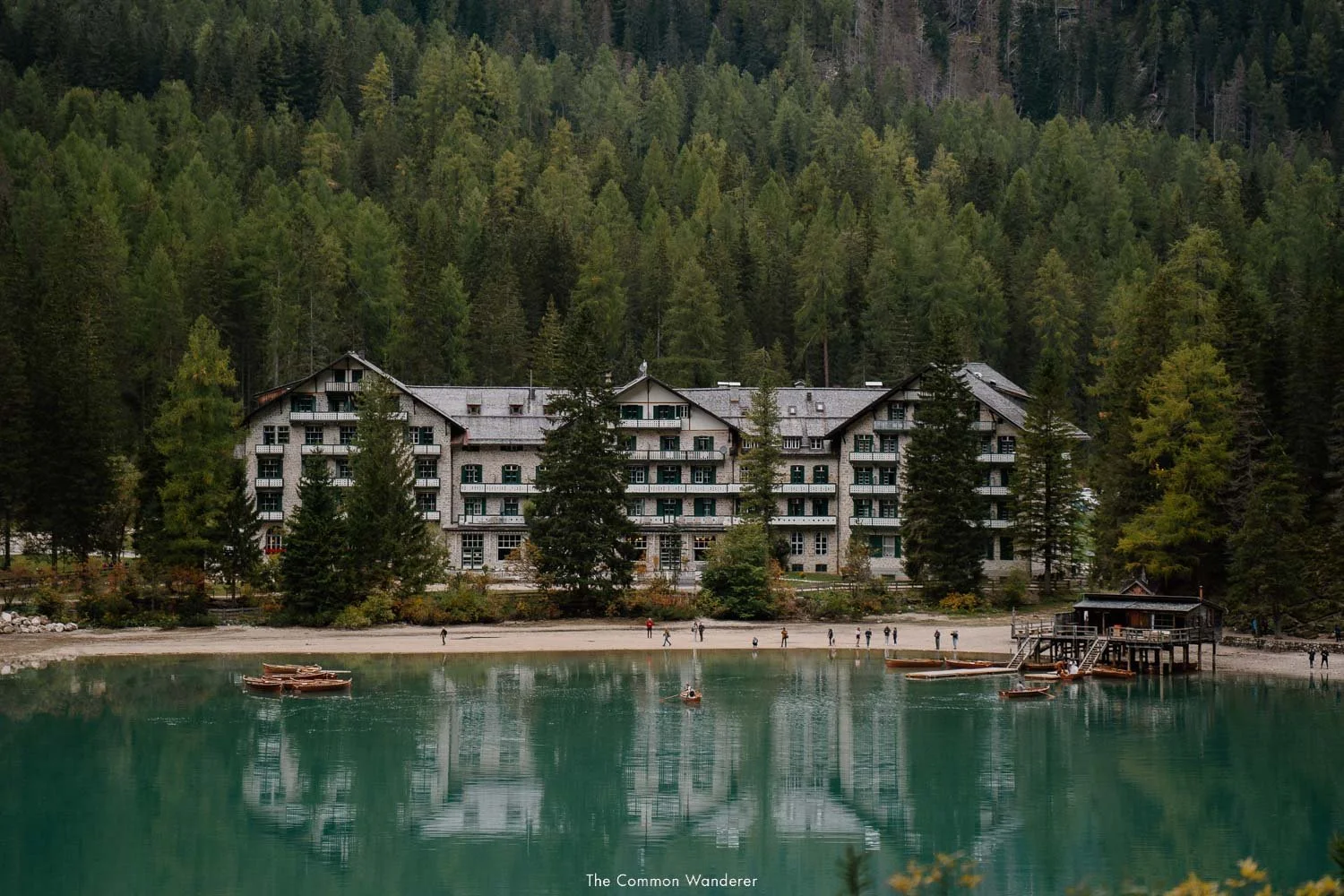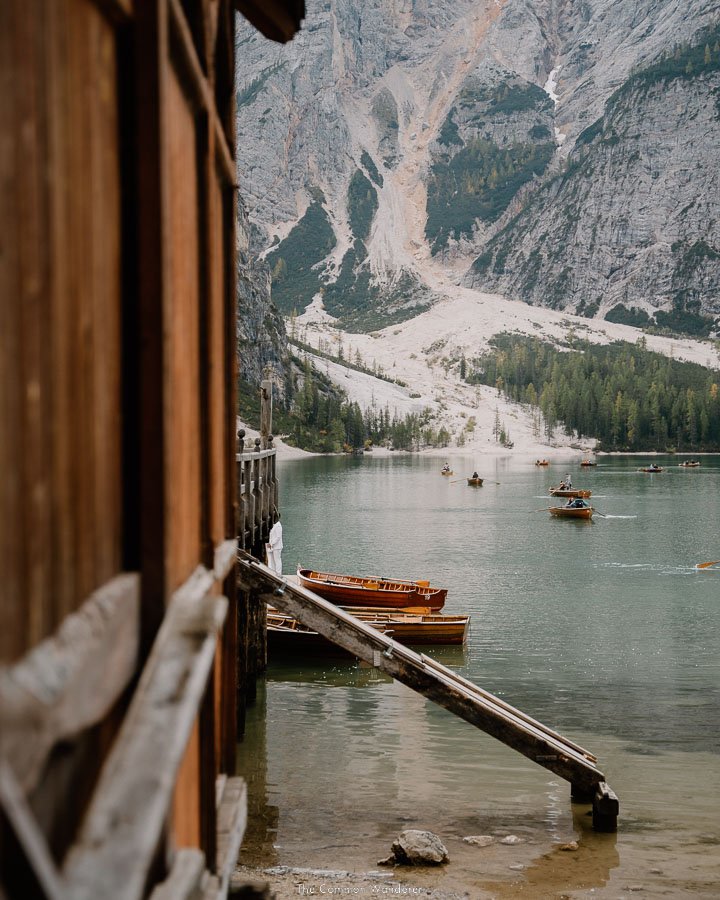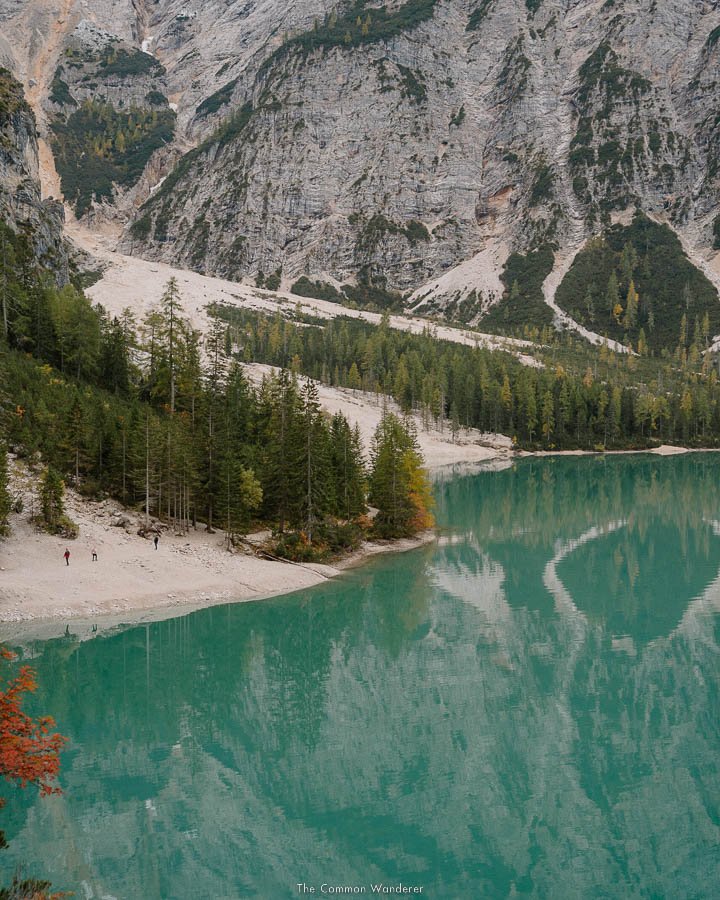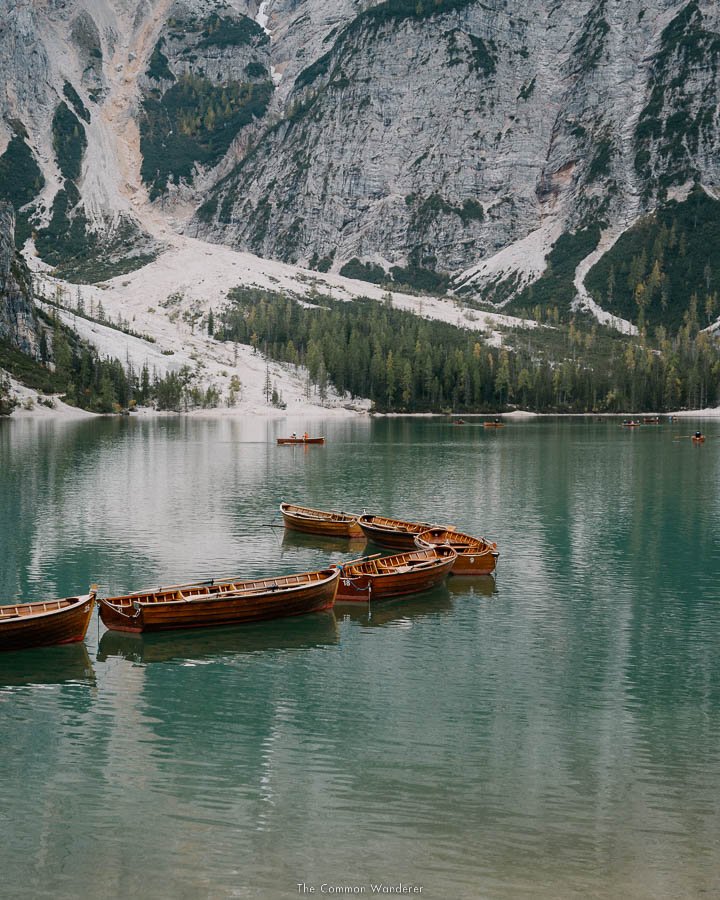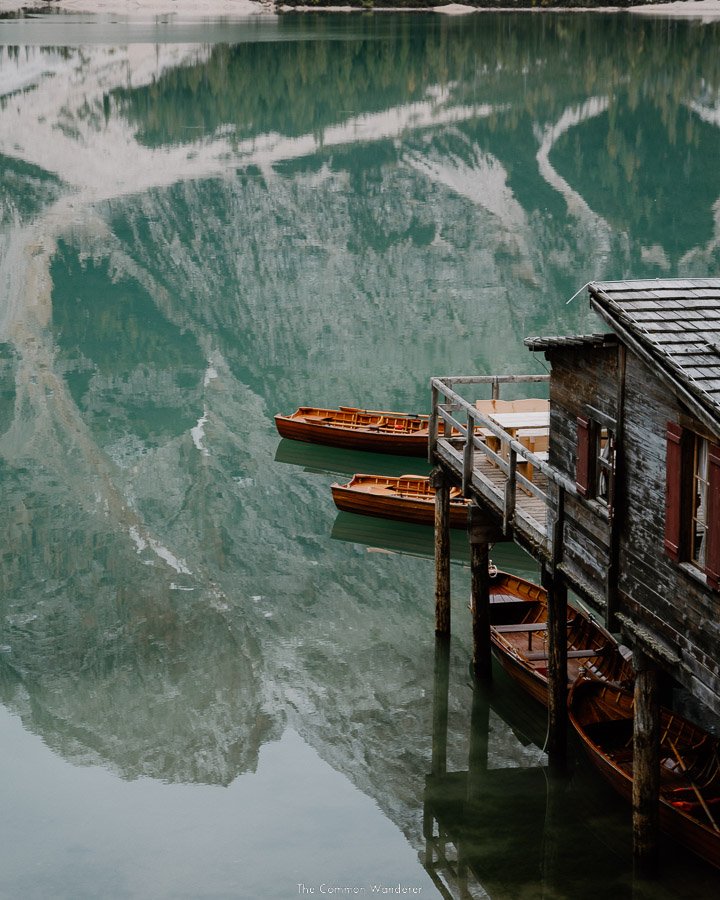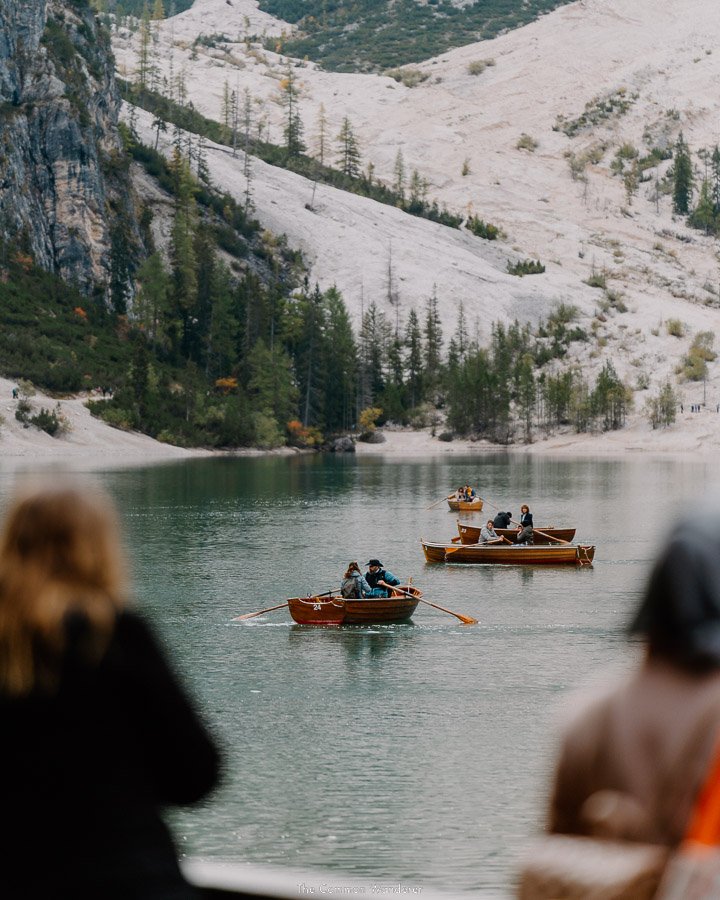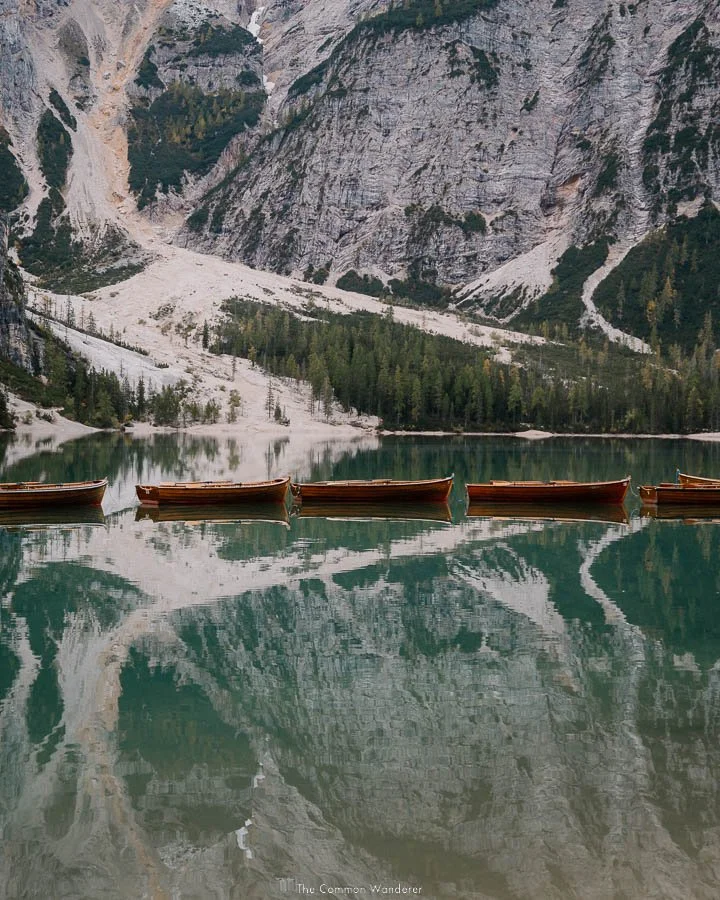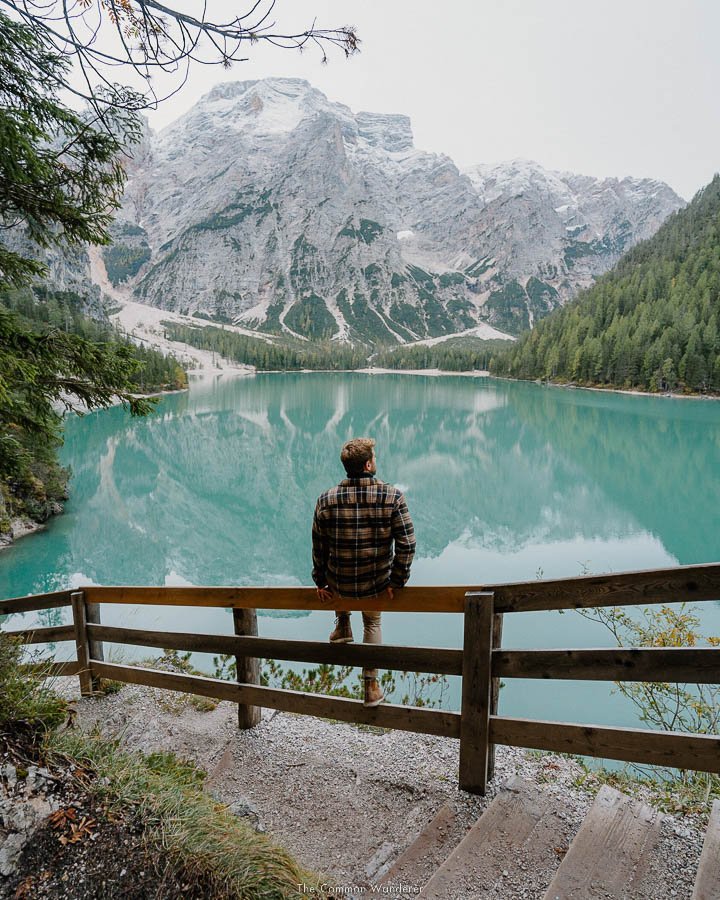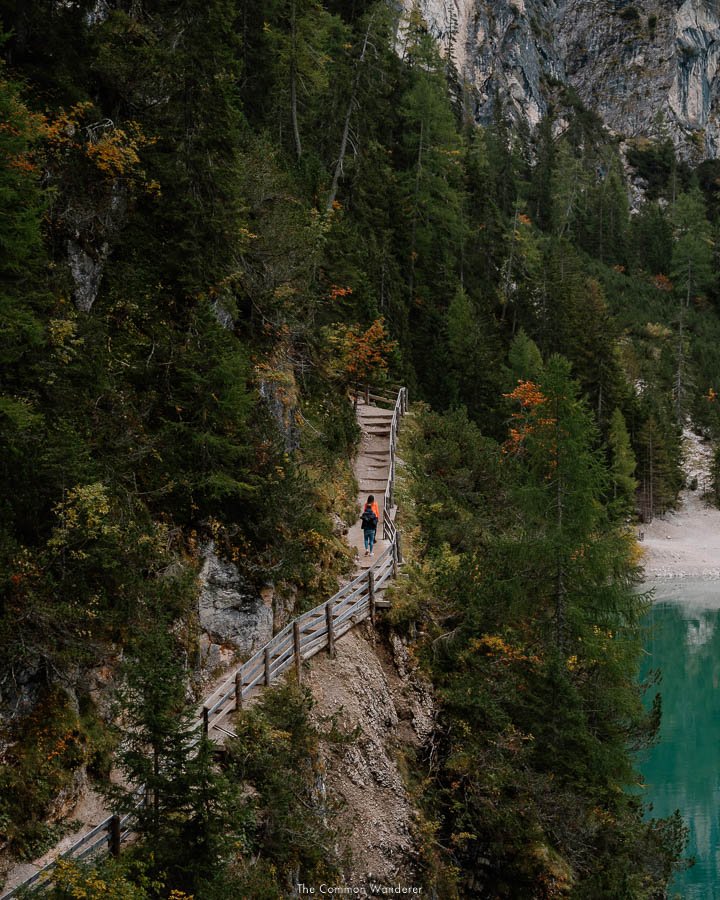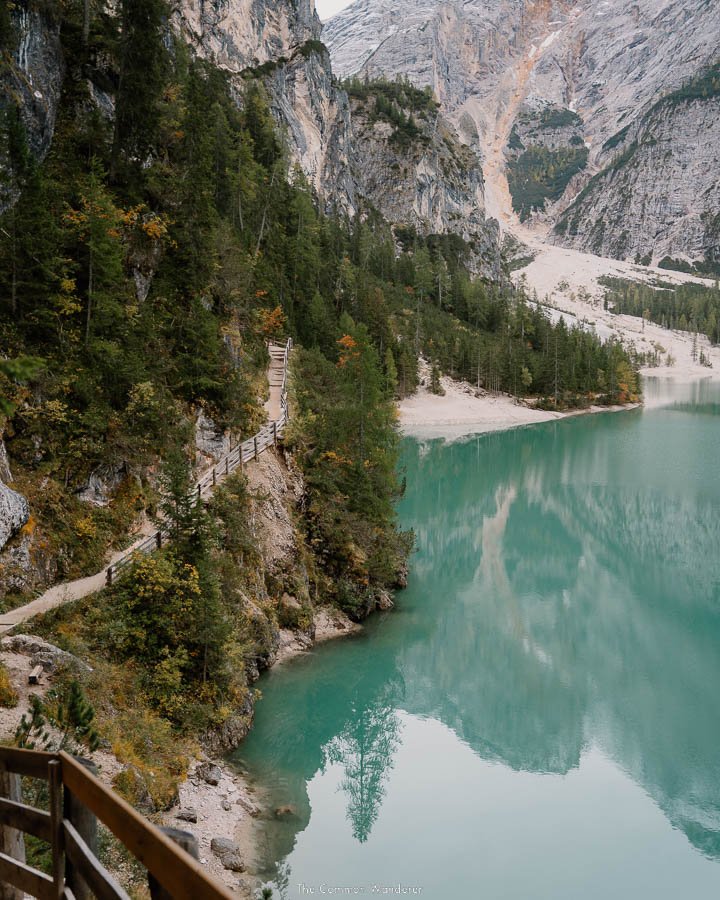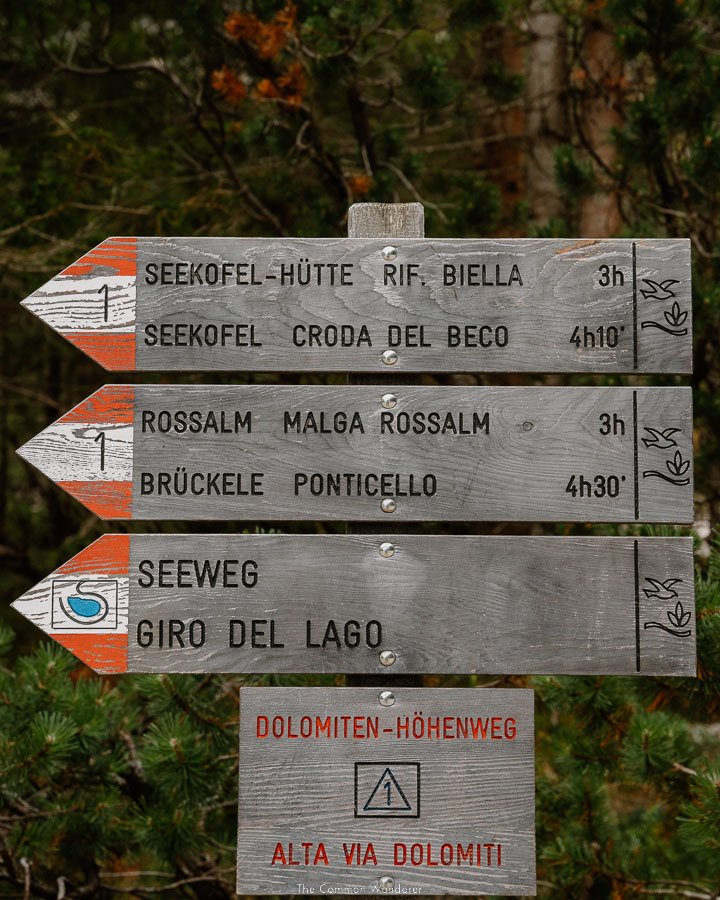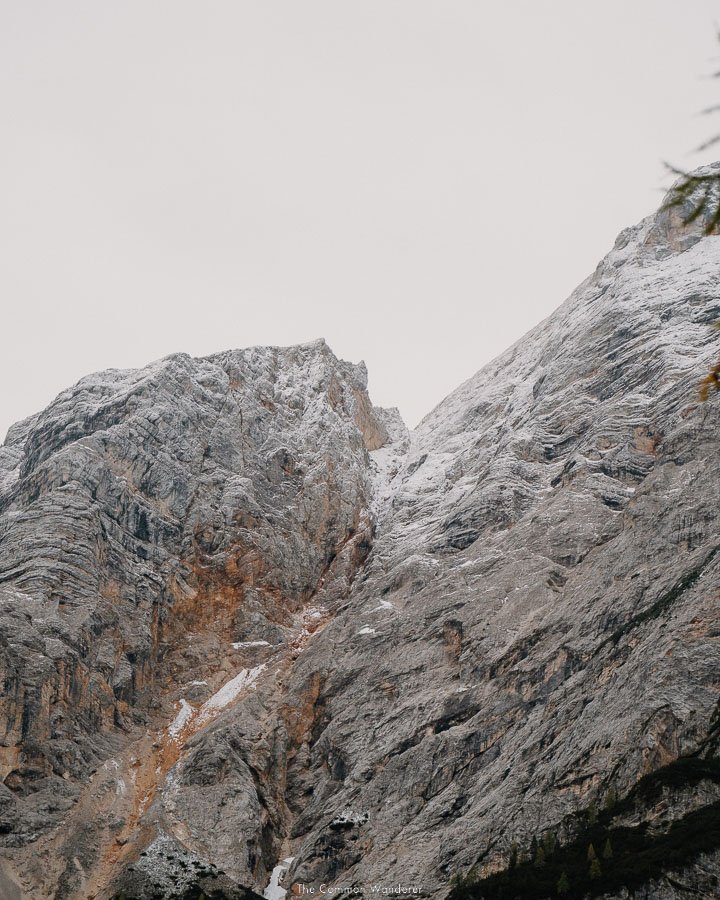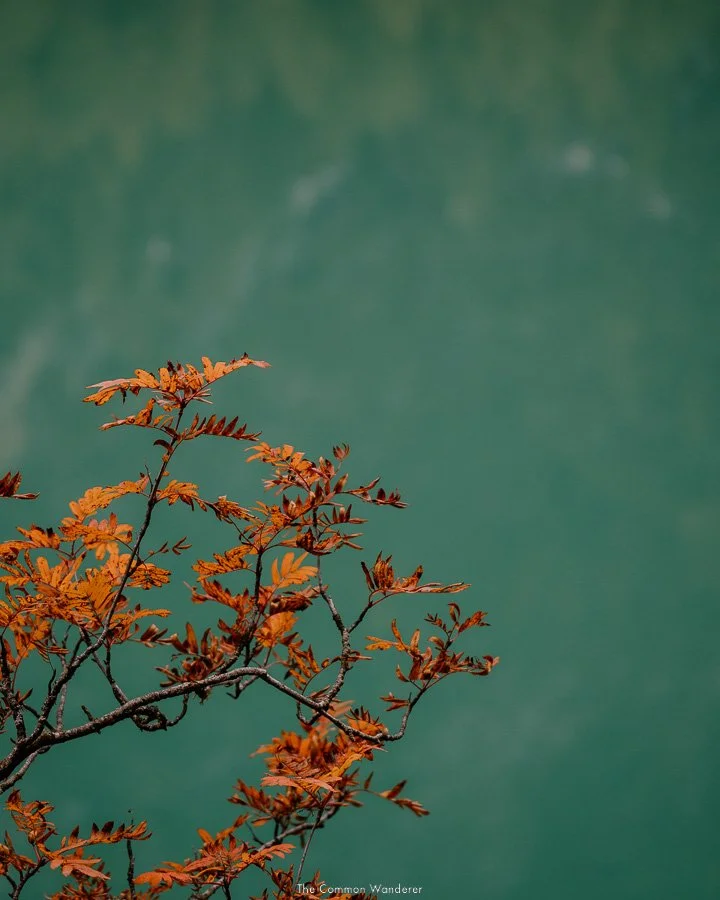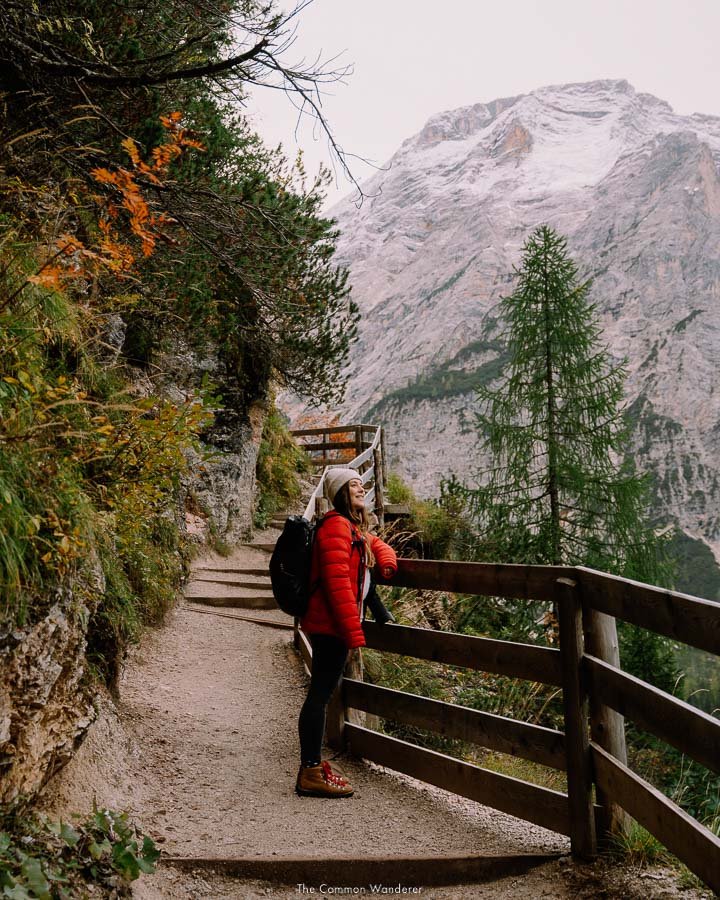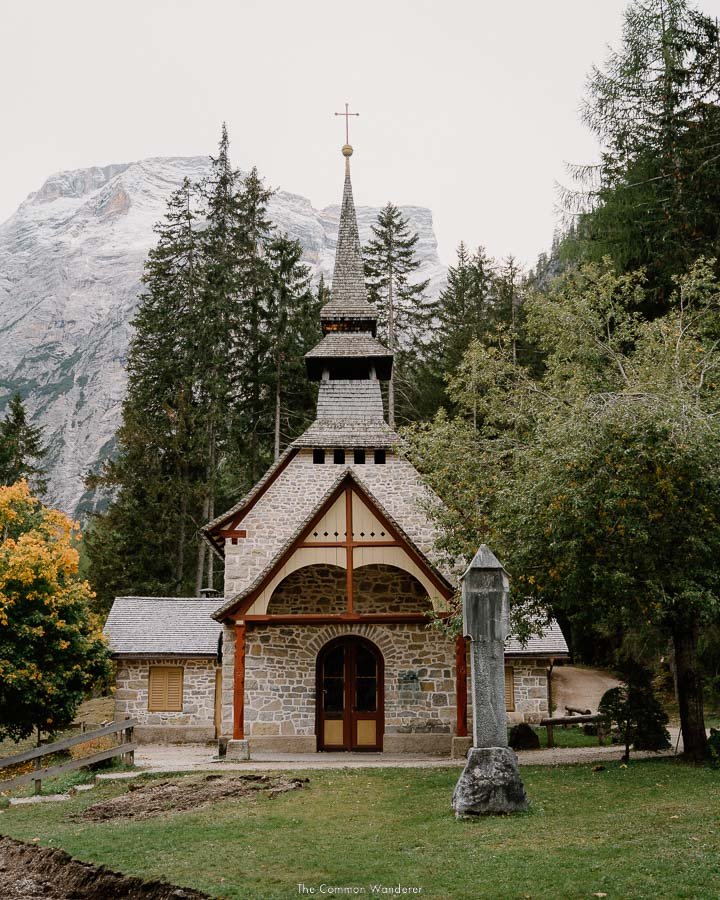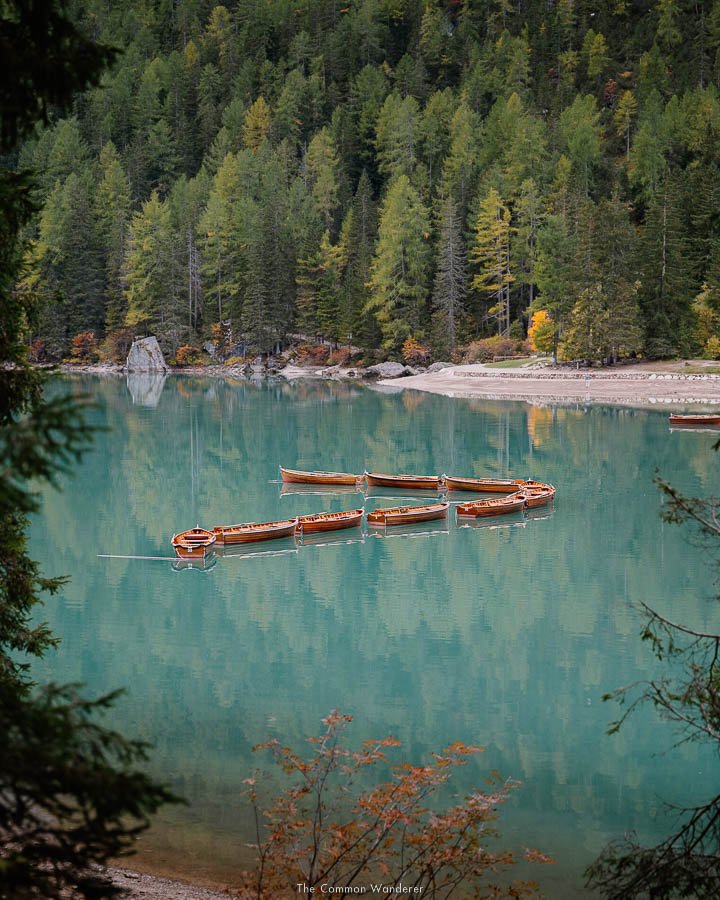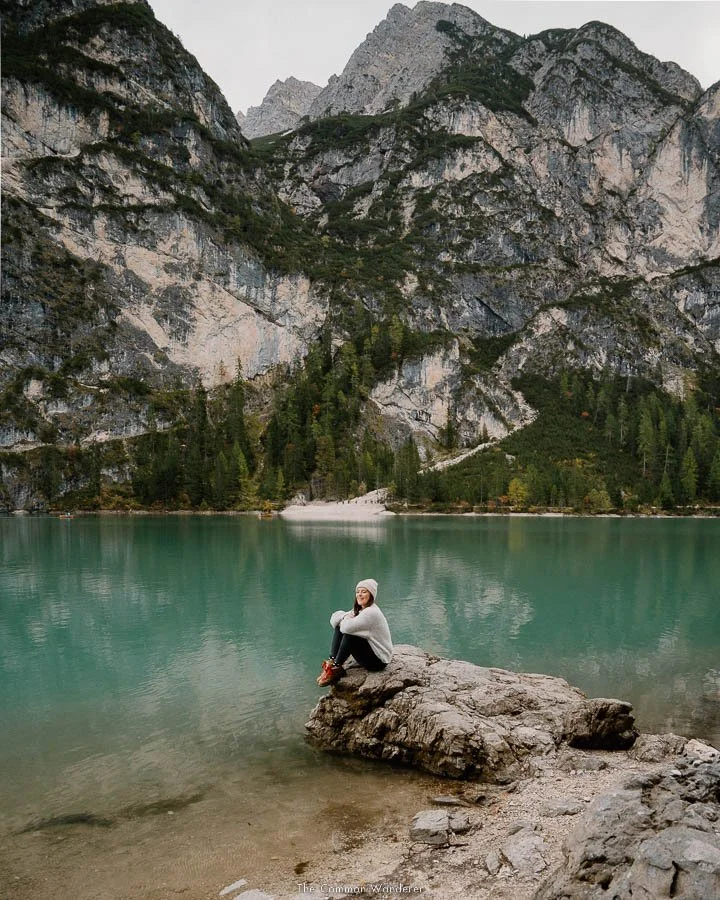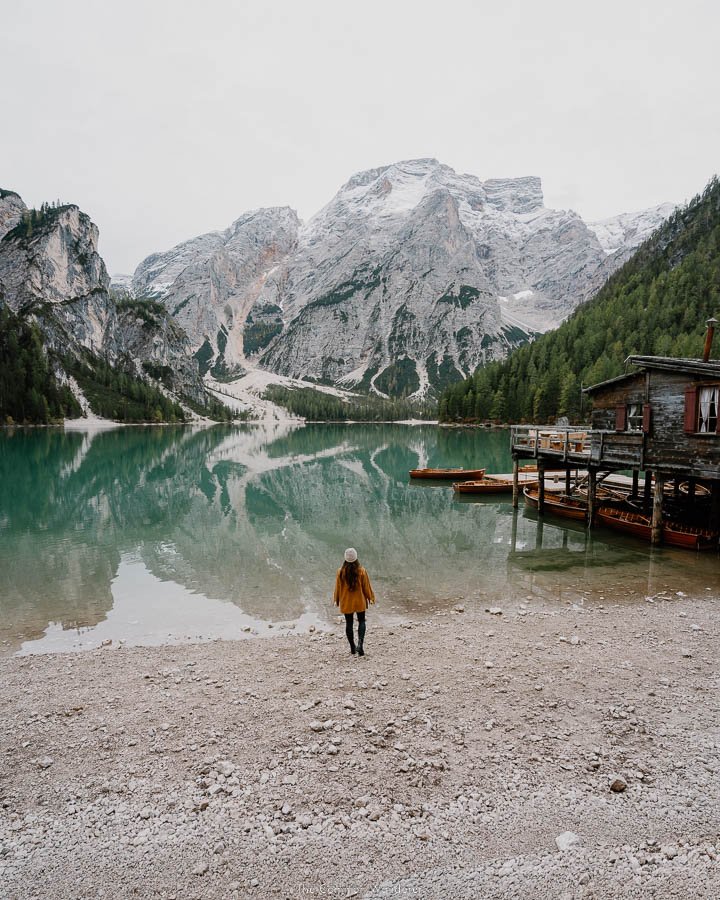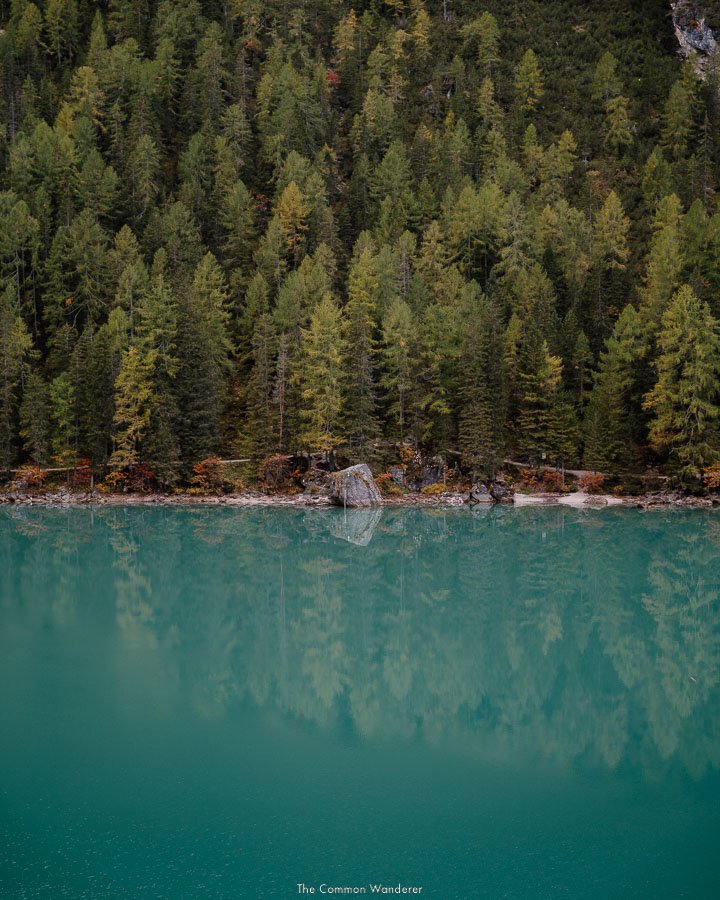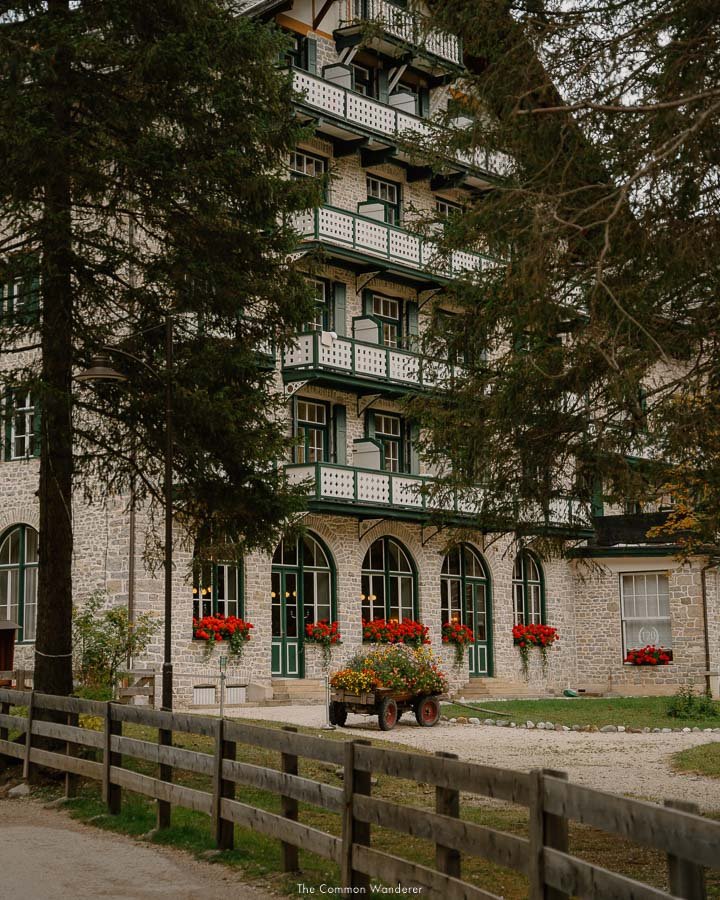How To Visit The Breathtaking Lago di Braies (Pragser Wildsee) in the Dolomites, Italy
One of South Tyrol’s most iconic sites, Lago di Braies is famous the world over. Plan your trip with our detailed guide, which includes everything you need to know to enjoy your visit.
There’s really not much more we could say about Lago di Braies that hasn’t already been said on Instagram captions and blog posts, but let it be known, it really is one of the most beautiful natural settings on our planet.
The most iconic sight in the Dolomites, Lago di Braies (Pragser Wildsee) is famous the world over for its emerald waters, ubiquitous boat house, beautiful spruce pines forests and towering limestone peaks.
Unsurprisingly, it’s more impressive in 3D, and worthy of a sunrise visit to avoid the crowds and savour the beauty (save for the 100’s of photographers that scramble for the best vantage points, even in the early hours - it’s not known as Lago di Instagram for nothing!).
Fortunately, a visit to Lago di Braies is so much more than a photo opportunity - from incredible walks in the surrounding hills, to a slow paddle across the emerald waters; our detailed Lago di Braies guide shares everything you need to know about this incredible attraction, including what to see, when to visit, how to get there, where to stay, and tips to enjoy your visit.
LAGO DI BRAIES
SNAPSHOT
REGION | South Tyrol, Italy
NAMES | Lago di Braies (italian), Pragser Wildsee (German), Lake Braies
ALTITUDE | 1,469m above sea level
WHAT TO DO | Walk around Lago di Braies, Photograph the lake, hire a row boat
WHERE TO STAY | Hotel Lago di Braies
HOW TO GET TO LAGO DI BRAIES | Car, bus or hike
WHERE IS LAGO DI BRAIES (PRAGSER WILDSEE)
Back when we first heard (or saw on Instagram) of this incredible lake in the Dolomites, we had no idea where it was. Even mapping it from above via google earth made it no clearer - it just looked like a tiny blue dot amongst some otherwise greens and greys of the mountainous landscape.
As it turns out, Lago di Braies is located deep in the Braies valley, in the South Tyrol region of northern Italy. As part of the scenic Fanes-Sennes-Braies Naturpark and the UNESCO World Heritage Listed Dolomites, Pragser Wildsee, as it is known in German, is actually located super close to the Austrian border and the region of Tyrol.
That doesn’t mean it’s easy to get to from major Austrian hubs though, but more on that below.
HOW TO GET TO LAGO DI BRAIES
GETTING TO LAGO DI BRAIES BY CAR
Most people tend to stay near Pusteria Valley and drive to Lago di Braies. This is definitely our recommendation, especially if you’re keen to be there for sunrise to avoid the crowds.
We’ve stayed in multiple different locations during our visits to Lago di Braies.
The first was in Sesto/Sexten at the incredible Berg Hotel, about a 30-minute drive from the lake. The second was in Welsberg/Taisten at the Stoffnerhof farm, a self-contained apartment on a working farm, around 20 minutes drive from the lake.
From most of the closest towns, Dobbiaco/Toblach, Monguelfo/Welsberg-Taisten, or Villabassa (Niederdorf), you’re looking at about a 15-20 minute drive.
It is possible to visit Lago di Braies from other popular towns in the Dolomites, including Cortina d’Ampezzo, or Brunico/Bruneck, but be prepared to travel many further distances.
If you’re staying in the Pusteria Valley, follow the via Pusteria (SS49) before turning onto the Franzione S. Vito via the roundabout.
Follow the signs from here, as there is really only one road in and out of Lago di Braies. Alternatively, use Google Maps from your location.
THE DETAILS
From San Candido, Villabassa & Dobbiaco | 20-25 minutes along the SS49
From Brunico | 30 minutes along the SS49
From Cortina | 55 minutes via the SS51 and SS49
To get to Lago di Braies from major airports in the region:
Milan | 4.5 hours/420km by car
Venice | 3 hours/200km by car
Verona | 3 hours/250km by car
Innsbruck | 2.5 hours/130km by car
READ MORE | Where to stay in the Dolomites
SUMMER ADVANCE BOOKING | To prevent over-tourism and environmental damage, an advance booking system is in place at Lago di Braies between July 10th and September 10th. You will not be able to get to the lake without a pre-booked parking or bus ticket unless you hike in, or ride. For further information, click here.
HIRING A CAR IN THE DOLOMITES
We highly recommend hiring a car for the duration of your stay in the Dolomites - it makes reaching all the wonderful natural attractions such as Lago di Braies very easy, and gives you far more freedom than public transport.
We’d recommend hiring a car in Bolzano, which is pretty much the gateway to your Dolomites adventures. Alternatively, you can hire a car at any arrival point in the surrounding regions and cities.
We generally use RentalCars.com to book rentals - check prices and availability for Italy here
BOOK | Check prices and dates for car rental here
READ | Our 7-day Dolomites road trip itinerary
PARKING AT LAGO DI BRAIES
The good news - parking is available at Lago di Braies. The bad news - it fills up super fast, especially in summer, and is quite confusing, to say the least.
We’ve tried to distil all the parking information below, but if things change, let us know in the comments below.
If you’re planning on arriving early (pre 10 am at the latest), there are two car park options which you’ll see on your right when you arrive - P3 is closest to the lake, however, we’d recommend parking in either P2 to avoid the crowds and make it easier to leave when you depart.
P4 PARKING
This is the closest car park to the lake but fills up super quickly.
It costs €8 for the first 3h if you arrive between 7 am and 5 pm, €5 for the first 3h from 5 pm – 8 pm, €3 total for arrivals from 8 pm – 7 am. After the first three hours, you’ll pay € 0.80 for each additional 30 minutes to a maximum of €14/day. In peak season a reservation for the day costs €18.
Campers are charged €8 for the first three hours, regardless of arrival time and a total of €25 for 24 hours. Campervans are allowed to sleep in the carpark overnight (there are no electricity or water unloading facilities), however, this may change in the future.
If you’re photographing the sunrise, P3 is the best place to park.
NOTE | Payment is taken at a machine which often seems to be broken, or in the hotel. Have cash available for payment just in case.
P3 PARKING
P2 is where we tend to park when visiting Lago di Braies, as it’s more affordable, at still super close to the lake.
Here, it costs $6 per day, and an old man will gain payment from you. It’s cash only, so make sure you bring a few coins.
Campers are charged €12 per day and €8 overnight. If you arrive after the attendant has left, you’ll be required to pay €8 in the morning, but if you arrive earlier in the day or leave later you’ll pay €20 for 24 hours.
It’s important to note that parking at Lago di Braies is limited, so access to the valley is only open when spaces are available. In summer, if the car park is full, you will not be allowed to drive further into the valley until spaces become available. You can, however, still visit on foot or bicycle, or via a #442 shuttle service from the pay and display carpark in Ferrara.
P2 PARKING
If you’re in a real pinch, P1 parking is your final bet. Located in the town of Segheria, 5.5 kilometres from the lake, you can catch a shuttle from here. Alternatively, there’s a hiking trail (#1) from town to Pragser Wildsee lake, which takes around 1.5 hours or jump on bus #442i or #439ii services.
Here, it costs $6 per day or €9 per day for campers.
ADVANCE BOOKING | To prevent over-tourism and environmental damage, the road to Lago di Braies is closed from July 10th to September 10th, between 9:30 am – 4 pm. Advance booking of parking spaces in the lakeside car parks (P2 & P3) is compulsory. Book your ticket here
PUBLIC TRANSPORT TO LAGO DI BRAIES
If you’re not keen to hire a car, the public transport system around the Dolomites is exceptional - the region is very well connected via a system of buses, regional trains and cable cars. And this includes the connections to Lago di Braies.
We recommend organising yourself a South Tyrol Mobilcard (€15, €23, or €28 respectively for 1, 3 and 7 days), and gain access to all the other transport options throughout the region.
Tickets can be purchased at tourist information centres, hotels, and ticket machines.
To get to Lago di Braies, there are a number of tourist shuttles that operate from major towns (and even hotels) in the Pusteria Valley.
BUS ROUTE #442
From Dobbiaco/Toblach, the #442 shuttle runs every 30 minutes from 8 am - 7:30 pm year-round. It also stops at Villabassa and takes around 30 minutes. Find the timetable here.
The journey costs € 5 per person per journey - or included in the South Tyrol Mobilcard). From July 10th – September 10th advanced booking is required.
If coming from further, such as San Candido/Innichen or Sesto/Sexten, take bus #446 to Dobbiaco/Toblach, or alternatively arrange a shuttle at your hotel.
BUS ROUTE #439
From the western towns, such as Monguelfo/Welsberg-Taisten, take the #439 shuttle (€ 5 per person per journey - or included in the South Tyrol Mobilcard), which departs every 30 minutes in the peak summer months.
The route commences at 6:30 am and stops at 5:30 pm, with the journey cost and restrictions the same as route #442. Find the timetable here (under Pusteria)
ADVANCE BOOKING | To prevent over-tourism and environmental damage, the road to Lago di Braies is closed from July 10th to September 10th, between 9:30 am – 4 pm. Advance booking of bus tickets & parking spaces at the lakeside car parks (P2 & P3) is compulsory. Book your ticket here
WHAT TO DO AT LAGO DI BRAIES
HIRE A FAMOUS ROW BOAT
Lago di Braies is no more majestic, nor romantic than from the water, in one of the delightfully pretty wooden rowboats that dot the lake near the equally photogenic boat house.
To fully embrace your visit to Lago di Braies, and the Dolomites in general, you suggest you hire one of the delightfully pretty wooden row boats and paddle to all corners of this picturesque lake.
It’s the perfect way to take in the vast natural beauty of the area from a completely unique perspective, for the towering peak of Seekofel is astoundingly impressive from the water. And while you’re at it, you should snap a LOT of photos.
The boats are human-powered and require a certain amount of rowing acumen to prevent you from rowing in circles for your 30 min - 1-hour boat ride (we absolutely didn’t learn this the hard way), so we suggest asking for tips from the boathouse ahead of your experience. Thankfully, it’s super easy once you get the hang of it, so don’t fret.
We suggest rowing the lake in an anticlockwise formation, straddling the western shores of the lake before settling under Seekofel, before slowly making your way back under the sheer cliffs and imposing rockface of Sasso del Signore.
From mid-May to the end of October, the handmade wooden boats can be rented from the picturesque boat house, la Palafitta. To hire a boat, head to the boathouse, which opens at 8:30 am during the summer months, and book your session - a 30-minute boat hire costs €19, and €29 for 1 hour (prices as of 2020).
We recommend arriving early, as by 11 am a lot of the boats are hired, and there can be a long wait - do note it is not possible to reserve boats ahead of time.
THE DETAILS
Opening hours | 8:30 am - 18:30pm July - August, 10:00 am - 17:00pm May, June, September, October
Cost | 30min boat hire: €19, 1 hour boat hire €29, €150 photography fee for the boathouse
TAKE THE LAGO DI BRAIES HIKE
Arguably Europe’s most beautiful lake, Lago di Braies is the jewel of the Dolomites, and a visit here is incomplete without a stroll around its storied shores.
The crystal clear alpine lake is surrounded by towering limestone peaks and dense spruce forests, which, coupled with the impossibly quaint lakeside cabin, provides the most picturesque photo opportunity.
As is the case in many of the world’s natural wonders, the popular viewpoint isn’t always the best, so for those wanting to see more than the stock standard views as well as escaping the hordes of crowds that mingle around the boat shed (hint: you should!), the easy 1-hour hike around the lake provides endless views, and multiple different perspectives, creating an even more alluring memory of the lake.
The hike commences at Lago di Braies hotel and can be followed either clockwise or anticlockwise (we suggest clockwise).
From the hotel, follow the path left past the lakehouse, before crossing a small wooden bridge over a creek and stepping into a dense forest of towering spruce trees that line the eastern shores. The views here are spectacular, so if you have time, we suggest sitting by on one of the supplied benches and taking it all in.
The hike then follows a narrow path up a steep incline, which gives you a greater appreciation of the lake’s majestic green/blues hues, especially under the summer sunlight.
The path begins to descend, this time into a small valley of rocks, displaced from high above from millennia of snowfall and storms. The barren landscape provides an open and uninterrupted view of the spruce-filled eastern shores.
Further along, you’ll pass a small waterfall, before encountering another vast rockfall from Seekofel mountain above. It’s from here the more arduous hikes begin (see below), and it’s also a great place to take a small break.
From here, it’s a less strenuous hike back to the hotel, skirting the lake’s edge, passing the famous Lago di Braies chapel, a small cafe, and a broad rocky ‘beach’.
It’s worth noting the hike is possible for almost all fitness types, and partially accessible for those with a disability (follow the path on the eastern edge of the lake).
THE DETAILS
Difficulty | Easy
Distance | 4km
Time | 1-2 hours
HIKE ABOVE LAGO DI BRAIES
While most people visit Lago di Braies for a few quick photos, there are a number of longer Dolomites day hikes that leave from here.
The best of these hikes is to the peak of Croda del Becco (Seekofel) from Lago di Braies.
The Lago di Braies to Croda del Becco (Seekofel) hike isn’t for the faint of heart - it’s a seriously tough, steep hike for seasoned hikers, yet the views from the top are as rewarding as any in the Dolomites.
Starting at the south-eastern end of the lake (trail #1 otherwise known as Alta Via #1), ascend towards Buco del Giavo, taking the steep and rocky path slowly to Forcella Sora Forno. From here, it’s another rocky section towards the cross at the peak of Croda del Becco (Note: there are some exposed sections which are secured with rope/chain).
The views from the peak are breathtaking - a 360° view of the surrounding mountains of the Fanes-Sennes-Prags Nature Park, as well as a unique view over Lago di Braies below.
The hike is physically demanding with an elevation rise of over 1000m, so we definitely recommend rewarding yourself by dropping into the quaint Rifugio Biella for lunch and a beer (mains: €10, beer: €4.20), before the descent back to Lago di Braies.
THE DETAILS
Difficulty | Hard
Distance | 11.4km
Time | 6 hours
Tips | Consider a guide, or another if you’re afraid of heights. Wear study boots with good grip
What to pack | Sturdy hiking boots, the Grayl GEOPRESS, a water purification bottle that allows you to fill up from any water source - invaluable in the mountains
READ MORE | 8+ Incredible Day Hikes in the Dolomites
ENJOY A LAKESIDE PICNIC
South Tyrol is famed for its cheese, cured meats and bread, so it would be remiss to not take a picnic and devour the deliciousness that is created in these mountains.
And Lago di Braies is the perfect place to take that picnic.
On the southern shores, under the imposing rockface of Seekofel, there are a number of picnic tables to set up your spread, and enjoy the far-reaching views back towards Lago di Braies hotel and boathouse. Enjoy freshly baked bread, draped with soft, flavourful cheese, while enjoying the serene sounds of the mountain.
Alternatively, join the hordes near Hotel di Braies, where the picturesque lakeside is scattered with a number of picnic tables, or grass to set down your blanket. We suggest visiting a nearby town (Dobbiaco is probably best) to load up on supplies from the local deli and bakery before arriving.
For the unprepared few who still wish to enjoy a picnic, there’s a recently opened bar/bistro located near Hotel Lago di Braies that serves South Tyrolean delicacies and sweets and hyper-inflated prices. The benefit to these prices, however, is their delightful terrace, with sweeping views across the lake.
VISIT THE LAGO DI BRAIES CHAPEL
On the western shoreline of Lago di Braies lies a picture-perfect chapel, Capella di Maria (Marienkapelle). The chapel was built in 1904, designed by the same architect who responsible for the Lago di Braies hotel, Otto Schmid, in typical South Tyrolean style.
Open to visitors in the summer months, the idyllic chapel and attached stables are simple, yet picturesque inside, and worth a quick stop during your walk around the lake.
The chapel also has a unique place in history - it was the designated meeting place of a German SS commander for a prisoner exchange during the Second World War, to ensure his own safety.
Nowadays, you’ll be safe and sound as you take in the cute interior and nearby horse stable.
GO FOR A SWIM IN PRAGSER WILDSEE
Unlike many other lakes in the Dolomites, such as Lago di Carezza, you are actually allowed to swim in Lago di Braies.
The catch is that you probably wouldn’t want to, given it’s a mountain glacial lake that barely gets above freezing most months of the year!
When we visited Pragser Wildsee, it was a brisk 5 degrees. In other words, there was no way we were planning on going for a swim, even in a wetsuit. And just a week later, we watch our friend and incredible photographer Carmen Huter run straight into the lake (admittedly, it was far warmer, but still!), enjoying the sweet healing properties only freezing glacial water can bring.
Now, we’re not looking back with any hint of regret, but we do wish to visit during the summer months to go for a quick dip after a long day’s hike.
But with a water temperature that barely lifts above 14 degrees, it’ll take a lot of mental strength!
THINGS TO KNOW BEFORE VISITING LAGO DI BRAIES
WHEN TO VISIT LAGO DI BRAIES
Lago di Braies is one of those places that you could visit at any time of the year and still have a memorable experience. In summer, watch the sunrise over the lake and turn the surrounding mountains orange. In winter, witness this alpine paradise frozen over.
However, if we had to choose the best time to visit Lago Di Braies, it would be spring or autumn.
In spring (June/early July), the lake’s water level is higher and more photogenic, while the rest of the Dolomites are under a sea of wildflowers. Snow also still covers the upper mountains, providing the most picturesque of backdrops to Lago di Braies.
In autumn, the surrounding larches turn shades of yellow and orange, which reflect off the lake and provide a stunning backdrop. Also, the sunrise hours are slightly more reasonable, so any photographers looking to be at the lake for sunrise can sleep in (sort of!). Unfortunately, the lake’s water level does reduce significantly over summer, however, this doesn’t detract from the beauty.
In winter, access is defined by the weather conditions and roads.
BEST TIME OF DAY TO VISIT LAGO DI BRAIES
We’ve got to be honest with you here - Lago di Braies is best enjoyed in the morning. And we mean early morning. Like 5 am early (or slightly later once daylight savings ends), or around 7 am if photography really isn’t your thing.
Regardless, you’ll soon forget about your comfy, warm bed when you watch the sunrise slowly light up the surrounding mountains before the lake comes alive in all shades of blue and green - trust us on this one.
Another benefit of arriving early is the reduced number of tourists, especially beyond the boathouse and chapel, as well as parking opportunities. If you’re a hiker, it’s even more important to get here early and start your hike before the heat of the day.
During our visit in autumn, we arrived at 6 am, and by the time we departed at 9 am, the parking spaces were almost full, so keep that in mind when planning your arrivals.
If you’re not a morning person, aim to arrive at 4 pm to avoid the day trip crowds descending on the lake midday.
With all of the above being said, Lago di Braies is still beautiful, whatever time you visit.
LAGO DI BRAIES MYTHOLOGY & HISTORY
Mythology within this region of Italy is important (you may have read our Lago di Carezza post to understand this already), and according to local legend, at the south end of the lake, below the imposing Croda del Becco, there was a gate to the Fanes underworld - a gate that could only be reached by boat.
It’s for this reason that Croda del Becco is actually called "Sass dla Porta" in Ladin, which means “Gate Mountain”.
Prior to legends, over 240 million years ago, the whole of the Dolomites was actually under the sea. The limestone Latemar mountains were formed when the sea levels began to fall, and the reefs began to resemble mountains.
As erosion occurred over millions of years, the valley of Braies was formed, and the body of water known as Lago di Braies (Lake Braies) came to be.
You can learn more about the geology of the Dolomites with this intriguing post.
IS IT LAGO DI BRAIES OR PRAGSER WILDSEE?
It’s both!
If you’re confused by this don’t worry, we were too. There's a reason why most places in the Dolomites have two, and sometimes three, names.
As mentioned above, the Dolomites are nestled in the uppermost corner of Italy on the border with Austria, and a geopolitical tug of war between Austria and Italy after WWI meant that South Tyrol was annexed and became part of Italy, and thus, the fascist government pushed a policy of ‘Italianisation’. This meant German was banned, despite most of the province speaking German, and siding with Austrian culturally.
Thankfully, there’s no longer a decree to speak Italian, and rather the region embraces its three main languages - German, Italian and Ladin.
ARE THERE TOILETS?
Rest assured, you won’t need to go behind a tree to relieve yourself at Lago di Braies - there are a number of toilets set around the lake. Hotel Lago di Braies has lovely toilets, but you’ll need to pay unless you’re eating or staying. It’s the same deal at Emma’s Cafe, near Lago di Braies Chapel.
At the southern end of the lake, there’s a set of toilets for those taking the lakeside hike.
DO I HAVE TO PAY TO ENTER LAGO DI BRAIES?
Lago di Braies itself is free to visit, and rightfully so. However, where the income needed to maintain and preserve the natural environment comes from is indeed the parking fees, which are quite expensive, even for South Tyrol.
Alas, the money goes to a good cause - keeping this natural paradise looking perfect.
RESPONSIBLE BEHAVIOUR AT LAGO DI BRAIES
With the rise of Instagram, so too have we seen a rise in those willing to break rules, disrupt others and be a general nuisance. And here, at Lago di Braies, we’ve seen some of the worst cases imaginable.
Droves of photographers breaking into the boat house prior to opening hours (note, there’s a €150 photography fee for the boathouse), people literally stealing row boats for their own photo shoot, drones buzzing relentlessly above, tourists trampling through the pristine wilderness to “get the shot”… you name it, we’ve seen it.
In isolation, this wouldn’t be a problem, but this is happening day after day, month and month, and year after year, leaving the local environment and community feeling the pain.
Instagram doesn’t give you a license to break the law in order to get a ‘banger’ shot, and there are plenty of ways to admire (and photograph) the lake’s beauty and still preserve it so that the generations after your Instagram shot can enjoy it too.
Be part of the solution, not the problem.
Here are a few other things to keep in mind:
Don’t drone | Yeah, it sucks that you can’t drone at Lago di Braies, but those are the rules (unless you gain approval from the tourism board or national park). There are signs literally everywhere, so “I didn’t know” is not an excuse
Call out rule breakers | At some point, we can’t complain about bad behaviour, we have to do something about it. Call out rule breakers at Lago di Braies, especially on Instagram
Pick up any trash you see | Thankfully we didn’t encounter too much rubbish in this area, but if you do happen to come across any litter, pick it up to dispose of properly.
Don’t litter | This goes without saying, but don’t drop your trash anywhere. Take it out with you.
Bring a reusable water bottle | There is no need for a modern traveller to buy bottled water, ever. We use The Grayl water filtration and purification bottles
Visit in shoulder season | Over tourism is a huge problem, and the easiest way you can help is to visit out of peak season
READ MORE | Learn our top responsible travel tips
WHERE TO STAY NEAR LAGO DI BRAIES
Looking for where to stay in the Dolomites? We’ve written a huge guide on where to stay in the Dolomites (it’s seriously huge!).
From luxury hotels to airbnbs, our guide has your Dolomites accommodation well and truly sorted.
But for Lago di Braies, see our recommendations below:
BERGHOTEL, SESTO | OUR RECOMMENDATION
We stayed at the incredible Berghotel during our stay in South Tyrol, and used it to explore Lago di Braies and beyond.
The Berghotel feels like an alpine hunting lodge, with thick stone walls, wood and leather interiors, and the odd stuffed trophy head on the wall. Heading up to the rooms is a different story altogether, sleek and Scandi-alpine in design, these are as modern and comfortable as it gets.
BOOK | BERGHOTEL, SESTO
STOFFNERHOF FARM, TESIDO
This is a truly authentic rural alpine accommodation experience; an idyllic farm nestled in the forested mountains, surrounded by beautiful nature and friendly chickens and cows (great for kids!).
The Stoffnerhof Farm is about a 20-minute drive from Lago di Braies but feels worlds away from the chaos of the lake. These self-contained apartments are enormous, with everything you need for a cosy stay, and the family who runs the farm are delightful hosts.
Breakfast is a real treat on the farm; each morning you’ll find a feast of milk, yoghurt and eggs straight from the farm, plus muesli, honey, bread and cheese produced in the regional valleys, plus homemade jam and spreads to keep you full up for a day of adventuring.
It's a truly local experience and a wonderful base from which to explore the Dolomites.
BOOK | FARM STOFFNERHOF
OTHER ACCOMMODATION NEAR LAGO DI BRAIES
HOTEL LAGO DI BRAIES
Sometimes all you’re really looking for in a hotel is location, and it’s safe to say that the Hotel Lago di Braies, right on the shores of the Dolomites’ most famous lake, has this pretty much nailed.
This three-star stone chalet might be a little dated in parts, but if you’re here for the lake, chances are you’re not actually that interested in spending much time indoors anyway, right?
BOOK | HOTEL LAGO DI BRAIES
Alternatively, search for more accommodation options in Braies here
CHALET TOBLACHER SEE, DOBBIACO
The ultimate in a romantic lakeside getaway, the beautiful adults-only Skyview Chalets Toblacher See, right on the edge of the Toblach/Dobbiaco lake are an accommodation experience out of this world.
These super modern chalets were just being finished on our last trip to the region, and they’re on our list for the next time we go back!
It’s super close to Lago di Braies (20 mins), and the perfect starting point for many a Dolomites adventure.
CAMPING AT LAGO DI BRAIES
It’s not possible to camp at Lago di Braies, unless you’re in campervan or RV, and park in P1 or P2 carparks (€20).
There are however, close by camping sites including Camping Olympia in nearby Villabossa, or Camping Toblacher See, near Lago di Dobbiaco.
TRAVEL INSURANCE | STAY SAFE IN THE DOLOMITES
We firmly believe that if you can't afford travel insurance, you really can't afford to travel. As the current pandemic has taught many; things can go wrong anywhere in the world and insurance is often the only way of mitigating any issues with minimal expense or stress for you.
For all travellers | HeyMondo - COVID-19 coverage, comprehensive travel + medical insurance, an app with 24-hour medical support, and no out-of-pocket fees.
*Get 5% off your policy by booking through our link here.
For digital nomads | SafetyWing - COVID-19 coverage, comprehensive travel & medical, and policies can be purchased while already abroad.
Car Insurance | Insurance4CarHire - a great annual car insurance policy
READ | Our ultimate guide to travel insurance
PLANNING A TRIP TO THE DOLOMITES SOON?
Check out these essential posts to help you have the best trip ever:
DOLOMITES | Our Dolomites Travel Guide, Top things to do in the Dolomites, Our 7-day road trip itinerary for the Dolomites, Where to stay in the Dolomites, How to get to the Dolomites
DOLOMITES DESTINATION GUIDES | A guide to Val di Funes, A complete guide to Alpe di Siusi, How to visit Lago di Carezza, our guide to Lago di Braies,
HIKES TO REMEMBER | 7 of the best day hikes in the Dolomites, including the famous Tre Cime De Lavaredo loop, Violet Towers hiking guide, Hiking to Lago di Sorapis, Cadini di Misurina
SOUTH TYROL | 19 amazing things to do in South Tyrol during Summer, plus everything we love about the beautiful South Tyrol region
PHOTOGRAPHY | Love our photography? Grab the presets we use on every photo here
RESPONSIBLE TRAVEL | Responsible travel is important. REALLY IMPORTANT. Learn our top responsible travel tips to help you, your family and friends travel more consciously around the globe
ECO-FRIENDLY PACKING ESSENTIALS | Don’t leave home without our favourite eco-friendly travel essentials
OUR ESSENTIAL DOLOMITES TRAVEL GUIDES
Some of the links on this guide to Lago di Braies/Pragser Wildsee post are affiliate links.
If you choose to purchase using these links, we receive a small commission at no extra cost to you. Please know that by using these affiliate links, you're directly supporting The Common Wanderer to stay wandering, the running costs of the site, and our ability to provide you with free content to help you on your travels.
That, and you're officially a legend.

